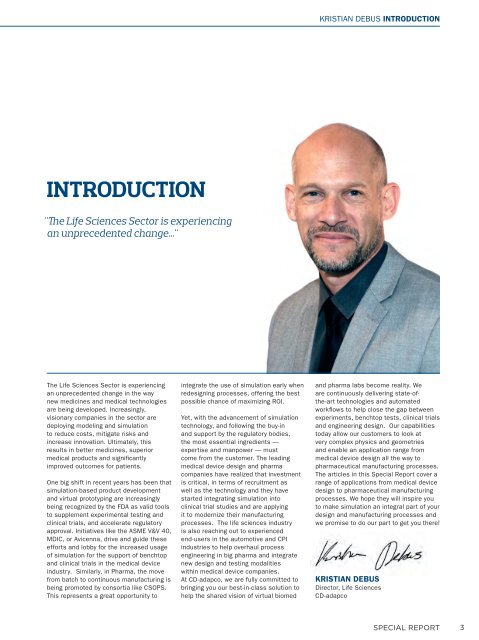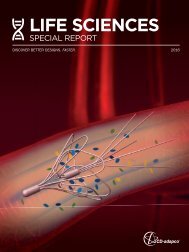Life science special report 161215 IY opt
Create successful ePaper yourself
Turn your PDF publications into a flip-book with our unique Google optimized e-Paper software.
KRISTIAN DEBUS INTRODUCTION<br />
INTRODUCTION<br />
"The <strong>Life</strong> Sciences Sector is experiencing<br />
an unprecedented change..."<br />
The <strong>Life</strong> Sciences Sector is experiencing<br />
an unprecedented change in the way<br />
new medicines and medical technologies<br />
are being developed. Increasingly,<br />
visionary companies in the sector are<br />
deploying modeling and simulation<br />
to reduce costs, mitigate risks and<br />
increase innovation. Ultimately, this<br />
results in better medicines, superior<br />
medical products and signifi cantly<br />
improved outcomes for patients.<br />
One big shift in recent years has been that<br />
simulation-based product development<br />
and virtual prototyping are increasingly<br />
being recognized by the FDA as valid tools<br />
to supplement experimental testing and<br />
clinical trials, and accelerate regulatory<br />
approval. Initiatives like the ASME V&V 40,<br />
MDIC, or Avicenna, drive and guide these<br />
efforts and lobby for the increased usage<br />
of simulation for the support of benchtop<br />
and clinical trials in the medical device<br />
industry. Similarly, in Pharma, the move<br />
from batch to continuous manufacturing is<br />
being promoted by consortia like CSOPS.<br />
This represents a great opportunity to<br />
integrate the use of simulation early when<br />
redesigning processes, offering the best<br />
possible chance of maximizing ROI.<br />
Yet, with the advancement of simulation<br />
technology, and following the buy-in<br />
and support by the regulatory bodies,<br />
the most essential ingredients —<br />
expertise and manpower — must<br />
come from the customer. The leading<br />
medical device design and pharma<br />
companies have realized that investment<br />
is critical, in terms of recruitment as<br />
well as the technology and they have<br />
started integrating simulation into<br />
clinical trial studies and are applying<br />
it to modernize their manufacturing<br />
processes. The life <strong>science</strong>s industry<br />
is also reaching out to experienced<br />
end-users in the automotive and CPI<br />
industries to help overhaul process<br />
engineering in big pharma and integrate<br />
new design and testing modalities<br />
within medical device companies.<br />
At CD-adapco, we are fully committed to<br />
bringing you our best-in-class solution to<br />
help the shared vision of virtual biomed<br />
and pharma labs become reality. We<br />
are continuously delivering state-ofthe-art<br />
technologies and automated<br />
workfl ows to help close the gap between<br />
experiments, benchtop tests, clinical trials<br />
and engineering design. Our capabilities<br />
today allow our customers to look at<br />
very complex physics and geometries<br />
and enable an application range from<br />
medical device design all the way to<br />
pharmaceutical manufacturing processes.<br />
The articles in this Special Report cover a<br />
range of applications from medical device<br />
design to pharmaceutical manufacturing<br />
processes. We hope they will inspire you<br />
to make simulation an integral part of your<br />
design and manufacturing processes and<br />
we promise to do our part to get you there!<br />
KRISTIAN DEBUS<br />
Director, <strong>Life</strong> Sciences<br />
CD-adapco<br />
SPECIAL REPORT<br />
3



